|
A man of many hats, Gary Gerani is known as the author of the pioneering book Fantastic Television, a crafty member of the Topps Trading Cards crew who thrilled twisted generations of kids and horror/sci-fi fans, and the screenwriter of Roger Corman's much-debated adaptation of Vampirella. However, horror fans may known him best as the co-writer who created Pumpkinhead along with the late Mark Patrick Carducci. This directorial debut for FX legend Stan Winston became one of the '80s' most indelidble movie monsters, rising from the ashes of distributor mishandling to become a major cable and home video hit and the basis for two sequels and numerous spin-off stories.
MONDO DIGITAL: How did Stan Winston become involved as director of Pumpkinhead?
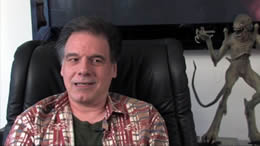 GARY GERANI: Billy Blake, Richard Weinman and Howard Smith were the original producers, and they were looking at people in the field. Stan had come off doing second unit photography for Aliens, so there was a feeling that he was a first class creature creator and a hell of a second unit director, so let’s do a deal where he can direct, which he wanted to do, and give this low budget movie a monster that can stand alongside Alien and Predator. What’s interesting is Predator originally had Pumpkinhead’s legs, these satyr-like legs, and it was difficult for him to walk, which is why in the film you only see quick glimpses. You really only see him walking in a church, and that’s because the stilts are off. The Predator has a lot of running around to do, so that’s why Pumpkinhead was given that unwieldy leg arrangement. It works pretty well, I think. Anyway… So they got Stan Winston whatever draft of the script we had at that point. GARY GERANI: Billy Blake, Richard Weinman and Howard Smith were the original producers, and they were looking at people in the field. Stan had come off doing second unit photography for Aliens, so there was a feeling that he was a first class creature creator and a hell of a second unit director, so let’s do a deal where he can direct, which he wanted to do, and give this low budget movie a monster that can stand alongside Alien and Predator. What’s interesting is Predator originally had Pumpkinhead’s legs, these satyr-like legs, and it was difficult for him to walk, which is why in the film you only see quick glimpses. You really only see him walking in a church, and that’s because the stilts are off. The Predator has a lot of running around to do, so that’s why Pumpkinhead was given that unwieldy leg arrangement. It works pretty well, I think. Anyway… So they got Stan Winston whatever draft of the script we had at that point.
Mark and I first played around with the revenge demon as a Lovecraftian scaly monster like the ones in our Super 8 projects. Then we got sidetracked into an interesting area; a lot of people thought if it’s called Pumpkinhead, it’s gotta have a pumpkin for a head. We got into trying to do a Sleepy Hollow type of creature where the witch would tell Ed Harley to go to a graveyard, dig up a corpse, cut the head off, bring it back; in the meantime she’s carving out this pumpkin with these evil eyes, and when he brings the body back, she brings it all to life. When Stan got involved, you’ve got arguably the greatest creature maker around. You’re not going to tell him to simply put a pumpkin on a human body, so we got back to the Lovecraftian idea. It’s still a bloated head, and we even threw in an extra line in the film about how he comes from the old pumpkin patch in the graveyard. The ultimate irony was this project came into being because of the title, but the alternate title, Vengeance: The Demon, became so prominent that when I was doing trading cards for pop horror movies, I thought I could squeeze my own monster into this. We made a deal with DEG, and those cards are labeled with both titles. The worst title they came up with was The Demon’s Revenge; that’s gonna pack ‘em in! Even Charles Band wouldn't be that trite. So wisdom prevailed and Pumpkinhead was allowed to stay Pumpkinhead.
So with Stan we thou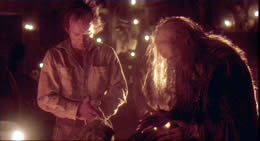 ght this guy would give us a great monster, and he liked the script, the whole simple moral fable of it. We did a few rewrites with him after that; Mark would go to California, and I had a 9 to 5 job at Topps in Brooklyn. I went to the set a couple of times. Mark would come back and we’d bang out our revised pages and hope Stan was pleased. One of the good things was Stan was such a horror buff in addition to a creature creator that we were all kind of on the same page. For the sequence in the burned-out church, Stan knew that we were all familiar with Howard Hawks’ The Thing, so he suggested we do the same kind of moment with a silhouetted Pumpkinhead standing in the doorway. Another interesting difference is that we wrote the witch to be more of a real character, meaning she has dialogue that, while she always spoke in that nifty way, she was a little more normal so she could entrap people. Stan wanted the ultimate picture postcard witch; he even said just give me the cliché but take it to the max! That’s essentially what Haggis is, the spooky old witch. Originally she was more like Jeanette Nolan where it’s conceivable she could say enough interesting things to lure you rather than a few little word bites, which is what we wound up with. Mark and I came from the same background when it came to how we viewed the supernatural with a physical world sense rather than a fairy tale, magical approach. We wanted it to seem like another life form from another dimension, like that famous line that “magic is just another person’s science.” What we view as magic is another realm of existence we’re not aware of yet. That’s how Stan and his sculptors approached Pumpkinhead, like he’s conforming to the physical laws of somebody else’s universe. Maybe what we perceive as Hell is simply an alien environment or dimension filled with exotic, ultra-vicious life-forms. ght this guy would give us a great monster, and he liked the script, the whole simple moral fable of it. We did a few rewrites with him after that; Mark would go to California, and I had a 9 to 5 job at Topps in Brooklyn. I went to the set a couple of times. Mark would come back and we’d bang out our revised pages and hope Stan was pleased. One of the good things was Stan was such a horror buff in addition to a creature creator that we were all kind of on the same page. For the sequence in the burned-out church, Stan knew that we were all familiar with Howard Hawks’ The Thing, so he suggested we do the same kind of moment with a silhouetted Pumpkinhead standing in the doorway. Another interesting difference is that we wrote the witch to be more of a real character, meaning she has dialogue that, while she always spoke in that nifty way, she was a little more normal so she could entrap people. Stan wanted the ultimate picture postcard witch; he even said just give me the cliché but take it to the max! That’s essentially what Haggis is, the spooky old witch. Originally she was more like Jeanette Nolan where it’s conceivable she could say enough interesting things to lure you rather than a few little word bites, which is what we wound up with. Mark and I came from the same background when it came to how we viewed the supernatural with a physical world sense rather than a fairy tale, magical approach. We wanted it to seem like another life form from another dimension, like that famous line that “magic is just another person’s science.” What we view as magic is another realm of existence we’re not aware of yet. That’s how Stan and his sculptors approached Pumpkinhead, like he’s conforming to the physical laws of somebody else’s universe. Maybe what we perceive as Hell is simply an alien environment or dimension filled with exotic, ultra-vicious life-forms.
How have you been involved in continuing the Pumpkinhead story?
I’ve written so many Pumpkinhead stories over the years including a Tales of Pumpkinhead TV series that included the origins of these creatures, which are very much like parasites. Some of that mythology even pops up in the Dark Horse comic Mark and I wrote back in the ‘90s. One of the concepts I created for that proposed TV incarnation was the Dark Pantheon, a horrific group made up of various demons, with each of them directly connected to a specific sin or evil of Man. Every other week would be a Pumpkinhead demon of revenge story, alternating with a new demon that was part of this pantheon. At the end of season one, I had some guy in a heat suit going down into the bowels of Hell to see all these demons massing for an attack. I knew that ending would be a real pip. In addition to the “new demon” angle, we’d be exploring various Pumpkinhead attacks throughout human history, with tales set in time periods ranging from Ancient Rome to the American west. There was even a story about a Holocaust survivor who manages to buy Pumpkinhead embryos through the black market, the starting point of a heinous scheme to punish the grandchildren of concentration camp runners who tortured his own family. We’re trying to take that universal concept of revenge and just explore it in every interesting, exotic way possible. There’s more to Pumpkinhead than just a backwoods story.
How did you come up with the idea of the teenagers as counterpoint to the main revenge story?
They were always a part of the story because the whole notion was two different worlds in collision where you have people from the city coming to what might as well be another planet. Having young people seems perfectly logical. You could do a Pumpkinhead story with more adult, interesting people coming in with their own agendas, but for the purposes of this simple, direct kind of tale, it makes perfect sense to provide city kids who might conceivably do something reckless like this. Plus, of course, no producer will let you make a commercial horror movie of this kind without putting young people through Hell! Fortunately, Ed Harley was a interesting grown-up character, and we lucked out by getting Lance. That was like a dream come true. I remember telling Mark we needed one of the astronatus from The Right Stuff; they all had that solid feeling of men of the earth, and we got one!
I 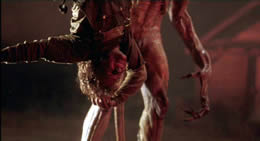 have to admit Mark and I were huge fans of Deliverance, and when we saw it together, we realized we had to do a creature feature in that world. It was too good, too evocative. That’s what Pumpkinhead is – by day it’s Deliverance, and by night it’s Mario Bava. That’s one of the reasons it’s a good picture, because it’s grounded in that reality. The backwoods meant a lot to Mark and myself as an environment to play with; we both really loved the atmospheric possibilities. At one point, Ed Harley was going to exit the story after the first act, and the tale would unfold as an almost documentary-like procedural. We soon realized that Ed was Pumpkinhead’s most interesting character, the guilt-choked protagonist, and who wants to spend screen time with a bunch of serviceable, but unexceptional, teenage victims? The movie is clearly about Ed Harley, which is why it begins with that flashback featuring him as a little boy. You then establish him as an adult, set up the heartfelt father-son relationship, and finally roll in the city kids. In no time this terrible accident occurs, and from then on there’s a serious sense of reality to the piece. Mark actually had a fondness for the “teens being chased through the woods” genre, and I sort of don’t. My mind spaces out because teenagers in a scenario like this really aren’t that interesting; they just have to come across as believable. In the original script we had a scene where we introduced the kids at a diner before you see them all on the road. It was as well-filmed as anything in the film, but it was Stan who cut it. I think he was right; it’s rare for the writer to say the director was right cutting a scene introducing a group of characters, but dropping that scene really did reinforce the notion that this was truly Ed Harley’s story, his own horrific, Faust-like morality play. That creative choice helped to make Pumpkinhead a better kind of fright flick. Still, it’s too bad this footage didn’t turn up as a deleted scene on the special edition DVD. have to admit Mark and I were huge fans of Deliverance, and when we saw it together, we realized we had to do a creature feature in that world. It was too good, too evocative. That’s what Pumpkinhead is – by day it’s Deliverance, and by night it’s Mario Bava. That’s one of the reasons it’s a good picture, because it’s grounded in that reality. The backwoods meant a lot to Mark and myself as an environment to play with; we both really loved the atmospheric possibilities. At one point, Ed Harley was going to exit the story after the first act, and the tale would unfold as an almost documentary-like procedural. We soon realized that Ed was Pumpkinhead’s most interesting character, the guilt-choked protagonist, and who wants to spend screen time with a bunch of serviceable, but unexceptional, teenage victims? The movie is clearly about Ed Harley, which is why it begins with that flashback featuring him as a little boy. You then establish him as an adult, set up the heartfelt father-son relationship, and finally roll in the city kids. In no time this terrible accident occurs, and from then on there’s a serious sense of reality to the piece. Mark actually had a fondness for the “teens being chased through the woods” genre, and I sort of don’t. My mind spaces out because teenagers in a scenario like this really aren’t that interesting; they just have to come across as believable. In the original script we had a scene where we introduced the kids at a diner before you see them all on the road. It was as well-filmed as anything in the film, but it was Stan who cut it. I think he was right; it’s rare for the writer to say the director was right cutting a scene introducing a group of characters, but dropping that scene really did reinforce the notion that this was truly Ed Harley’s story, his own horrific, Faust-like morality play. That creative choice helped to make Pumpkinhead a better kind of fright flick. Still, it’s too bad this footage didn’t turn up as a deleted scene on the special edition DVD.
Did you have much input in Pumpkinhead's finalized appearance?
 We weren’t all that involved. Stan’s people provided us with some drawings with several views of the head, and Mark and I both had that hanging over our typewriters. We weren’t consulted in terms of what this thing should look like. Alec (Gillis) and John (Woodruff Jr.) basically created it during their tenure at Stan’s company, and Winston gave them a lot of leeway. He’d say I directed the movie, they created the monster. They just used their own initiative and said, it’s a demon. What doesn’t look conventional or corny? They eliminated horns but thrust up his shoulder blades to convey it in an interesting way. With the Dark Horse Comics and model kit (which was called Pumpkinhead Metamorphosis), Mark and I had talked in interviews about the idea of a winged Pumpkinhead. I thought what if one of the targets gets in a plane or chopper or something, how can the hit-man demon go after his target? In this case, unholy nature finds a way. In a sequence Mark and I were writing that formed the basis for both a comic and the model kit, this would be the big third act moment. You see Pumpkinhead cocooning himself up in a tree, Mothra-like, and then this new, winged incarnation of the creature dramatically emerges and goes after his airborne victim, snatching him from a crop-dusting plane and shoving his head into the propellers! Actually, one of those ‘90s model kits gave the world a winged Pumpkinhead, and that particular kit happens to be my personal favorite. In a way, the movie Jeepers Creepers 2 tapped into this notion, with a slain child spurring character motivation and a winged demon-like monster figuring into the equation. I had a bit-of-business in one of the sequel scripts where the targets are trying to escape and this whirlpool of leaves suddenly takes form before their astonished eyes. Pumpkinhead emerges from it, and the concept is, he is a part of the land, the local environment, and he can command these natural forces to a limited degree while fulfilling his murderous agenda. The challenge is to come up with fresh ideas for this exotic bogeyman, who is pretty much one note: he tortures and he kills. Mostly, this is psychological torture, not gory in-your-face stuff. We also had an underwater bit with Pumpkinhead pulling the victims legs from below, sadistically letting them go for a few moments, then pulling them down again. This creature really wants you to suffer before he snuffs the life out of you. I suppose you can say he’s the dark side of our psyche given tangible form, a very real “monster from the id.” We weren’t all that involved. Stan’s people provided us with some drawings with several views of the head, and Mark and I both had that hanging over our typewriters. We weren’t consulted in terms of what this thing should look like. Alec (Gillis) and John (Woodruff Jr.) basically created it during their tenure at Stan’s company, and Winston gave them a lot of leeway. He’d say I directed the movie, they created the monster. They just used their own initiative and said, it’s a demon. What doesn’t look conventional or corny? They eliminated horns but thrust up his shoulder blades to convey it in an interesting way. With the Dark Horse Comics and model kit (which was called Pumpkinhead Metamorphosis), Mark and I had talked in interviews about the idea of a winged Pumpkinhead. I thought what if one of the targets gets in a plane or chopper or something, how can the hit-man demon go after his target? In this case, unholy nature finds a way. In a sequence Mark and I were writing that formed the basis for both a comic and the model kit, this would be the big third act moment. You see Pumpkinhead cocooning himself up in a tree, Mothra-like, and then this new, winged incarnation of the creature dramatically emerges and goes after his airborne victim, snatching him from a crop-dusting plane and shoving his head into the propellers! Actually, one of those ‘90s model kits gave the world a winged Pumpkinhead, and that particular kit happens to be my personal favorite. In a way, the movie Jeepers Creepers 2 tapped into this notion, with a slain child spurring character motivation and a winged demon-like monster figuring into the equation. I had a bit-of-business in one of the sequel scripts where the targets are trying to escape and this whirlpool of leaves suddenly takes form before their astonished eyes. Pumpkinhead emerges from it, and the concept is, he is a part of the land, the local environment, and he can command these natural forces to a limited degree while fulfilling his murderous agenda. The challenge is to come up with fresh ideas for this exotic bogeyman, who is pretty much one note: he tortures and he kills. Mostly, this is psychological torture, not gory in-your-face stuff. We also had an underwater bit with Pumpkinhead pulling the victims legs from below, sadistically letting them go for a few moments, then pulling them down again. This creature really wants you to suffer before he snuffs the life out of you. I suppose you can say he’s the dark side of our psyche given tangible form, a very real “monster from the id.”
Were you trying to create an iconic horror figure at the time?
When you write anything, you have your dreams and hopes. It didn’t occur to me since there was so much happening with creatures at the time like Aliens; it was only after we saw the finished picture that we said, boy, the combination of the movie being kind of good and the creature being interesting, yeah, that worked. Before long Pumpkinhead really was standing alongside the other monsters with its model kits, that same kind of integrity. Of course, all those others – the Alien, the Predator – were science fiction entities, while ours was purely supernatural. Then we thought, all right! We lucked out and did manage to get our own "Famous Monster." We got some assignments but only a few things happened after that. Mark and I did a number of scripts for New Line, like an adaptation of Light at the End, an urban Skip & Spector novel with one hell of a great climax: a vampire trapped in a subway train that’s about to roar through a tunnel and zoom into the damning daylight of a bridge crossing. Every day I was taking the same exact train from Coney Island all the way down to 59th & Lexington, so I crossed over the Manhattan Bridge constantly. Mark and I knew that this bridge crossing created all kinds of interesting strobing effects within the passenger car, an extremely cinematic bit of business. So when we adapted that novel we gave everything and amped it up, sort of like The French Connection as a vampire thriller. We adapted novels that New Line wanted turned into horror films, and Mark worked on an alternate version of the Child’s Play sequel. They were commissioning different writers like a bake-off but ultimately went with the same writer if I’m not mistaken. Mark also sold Buried Alive which became the first thing Frank Darabont ever directed.
 How did you become involved in writing Vampirella for Roger Corman? How did you become involved in writing Vampirella for Roger Corman?
I wrote it as a major studio release, with all the trimmings, and it got a great response. I was told Burton was interested, which doesn’t surprise me, since it was such a flamboyant concept to begin with, rich with a lot of colorful fantasy. Unfortunately, that movie was filmed for a ridiculously low budget, and the special effects were an embarrassment. Naturally, all the expensive action set-pieces had to be eliminated, but I did remain true to the spirit of Archie Goodwin’s classic stories for Warren, even down to some specific dialogue. Soon after, everybody seemed to be doing vampire action flicks and TV shows. The Buffy/Angel relationship was without question a flip of Adam Van Helsing and Vampirella’s special bond: a professional slayer falling in love with a heroic vampire. But will devilish circumstances force a blood-deprived vampire to prey on the very person he or she loves? The Buffy series re-did that climactic moment from Vampirella in the High School Graduation season finale, and at least one enterprising fan had fun editing both sequences together, which proved rather humorously that both scenes were, in essence, covering the same exact character/thematic material in just about precisely the same manner. Gratifying, I suppose. So how come I’m not writing the Avengers movie? (laughs). Joss Whedon – an exceptional writer, by the way - also re-imagined Vampirella’s government-created, paramilitary supernatural unit Operation Purge into The Initiative, and a good deal of the Purge concept also turns up in John Carpenter’s Vampyres. Hey, a savvy writer goes down a certain genre path, and he’s bound to come with the same clever material you were inspired to create going down that very same conceptual/thematic road. Happens constantly. Although the Vampirella feature-length TV pilot never spawned a series, I did wind up writing a series bible, which contained 22 hour episode concepts. At the end of Season One, for instance, a framed Vampi’s on the run from her former friends at Operation Purge, with only Adam Van Helsing still trusting her. He finally tracks her down and discovers this mini-space ship she’s created, a one-woman vehicle that will take her back to her home world. Season Two begins with Vampirella’s actual visit to Draculon – how cool is that?! But hey, it was never meant to be. Too bad, because I always rather enjoyed the notion of vampirism being an extraterrestrial condition that was brought to our planet. Indeed, everything we Earth folk have ever viewed as “magical” or “supernatural” is in fact connected to this exotic alien civilization, since Dracula arrived here ages ago and began spreading his corrupted, mutated version of vampirism. It’s sort of like H.P. Lovecraft meets Nigel Kneale – my kind of sci-fi fantasy.
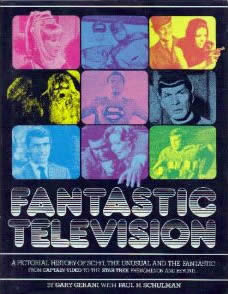 What led you to write Fantastic Television? What led you to write Fantastic Television?
The first book on horror movies was 1967's An Illustrated History of the Horror Film, and Carlos Clarens briefly mentions The Twilight Zone, along with some other sci-fi TV series, and says something like, “the charting of that considerable territory belongs elsewhere.” I knew when I read that, that I was going to be that “charter” someday. I’d been watching these shows my whole life, and there was very little written about them. Fantastic Television had the virtue of being the first book of its kind, and it was quite well-received in its day. A few years later, VCRs came along, and fans used the book’s Episode Guides as checklists for the various shows they were taping. So FT did a lot for me, and I’m very happy about that. I guess my three big claims to fame, so far at least, are that book, my hilarious status as the “Card King,” and good old Pumpkinhead.
How did you become associated with Topps trading cards?
I have a saying: fiction is the dream, non-fiction pays the bills. In a way I’m very lucky; I’ve always been able to support myself doing the things I love – thank God, because I probably couldn’t function working at anything conventional or non-creative. Back in the early ‘70s, I had just graduated from the High School of Art and Design,  and my first professional writing assignment was “becoming” the Creature from the Black Lagoon for a humorous, autobiographical feature article. This appeared in an early issue of The Monster Times, a kind of tabloid answer to Forry’s monster mag. This piece made me a bit of star up there, and before I knew it, I was “ghost writing” Godzilla’s monthly column as well. Since I was now an associate editor, I was given a free classified ad in the back of the publication. It said something like: "WANTED! 16mm SCI-FI AND HORROR FILMS." Len Brown, who was Creative Director at Topps, was also a film collector, and got in touch with me. Before long I was writing, editing and art directing trading card sets for the company, something I do to this day. It’s actually a lifelong creative relationship; I’m preparing a new Star Wars Galaxy series even as we speak. and my first professional writing assignment was “becoming” the Creature from the Black Lagoon for a humorous, autobiographical feature article. This appeared in an early issue of The Monster Times, a kind of tabloid answer to Forry’s monster mag. This piece made me a bit of star up there, and before I knew it, I was “ghost writing” Godzilla’s monthly column as well. Since I was now an associate editor, I was given a free classified ad in the back of the publication. It said something like: "WANTED! 16mm SCI-FI AND HORROR FILMS." Len Brown, who was Creative Director at Topps, was also a film collector, and got in touch with me. Before long I was writing, editing and art directing trading card sets for the company, something I do to this day. It’s actually a lifelong creative relationship; I’m preparing a new Star Wars Galaxy series even as we speak.
For the record, my first day on the job I doubled for Boris Karloff in a movie set called Creature Features. Universal back then had the right to license their monster characters, but not the supporting “human” players. So we had to replace actor’s heads with the heads of people who worked at Topps, to avoid copyright violations. Then there were the never-ending stream of Wacky Packages that needed to be created, series after series. Half a dozen of us would sit around the office and stare at some product I just picked up from the supermarket; one person might come up with the main gag, another a cool idea for the illustration parody. It reminded me of the process on the old Dick Van Dyke Show, with the comedy writers sitting around sharing ideas. Stan Hart, head writer of The Carol Burnett Show and the author of Mad Magazine’s movie and TV parodies, was part of our regular group of zanies, which also included comic artist Art (Maus) Spiegelman. We all knew what it was like as a kid in school, and we tapped into that gleefully subversive side of the American youngster. It was a real split personality in that company between that and the sports division. That was way ahead of the snarky 21st century humor that’s everywhere now. We tapped into that and gave it to the kids. Of coruse, the mothers of America hated our guts because those damn Wacky Packages would stick to their refrigerators. Occasionally they would transfer a call from the outside, an irate mother, to talk to me.
I remember one of the first things I tried to do was a sequel to the legendary Mars Attacks!, but they pulled out the sales figures. It bombed, but it became a major cult item. Originally there was controversy because of the violence. The concluding idea was a sci-fi set wouldn’t sell, but the gross humor stuff would. I finally managed to sell them on an original sci-fi series when dinosaurs became popular in the 1980s. Unlike Mars Attacks!, which was handled totally straight, Dinosaurs Attack! combines heavy melodrama with some satire and over-the-top humor, which stems directly from the outrageous of the concept itself: dinosaurs are alive again, and are chomping their way through our fatuous society. The problem when a filmmaker tackles this sort of thing is the temptation to do an out-and-out farce, instead of allowing the laughs to flow naturally from the exaggerated situations. Tim Burton licensed Dinosaurs Attack! the same time he got the rights to MARS, and it was clearly his intention to do a send-up of Ed Wood-type movies (he had just finished up that movie bio). Joe Dante had also optioned the property – Dinosaurs Attack! predates the Jurassic Park novel, which eventually derailed Joe’s project -- and he was preparing to go in a “funny” direction as well. No offense to these fine filmmakers, but to me, this is the fastest way to kill a franchise. Viewers take their alien attacks, dinosaur thrillers and superhero adventures very seriously. Burton’s Mars Attacks! bombed and hurt the franchise the way the old Batman TV series humiliated DC’s property for decades by presenting the Darknight Detective as an object of ridicule. Sure, you may achieve a few cheap laughs, but goofing on a property that fans love is extremely dicey, especially given today’s tastes. I’m currently trying to revive Dinosaurs Attack! as a Battlestar Galactica-type series, but with ironic humor around the edges. This way, you have a chance to build your characters, and develop that all-important cult following which generally turns into a licensing bonanza. Look at Lost, for Heaven’s sake, or True Blood, or Buffy. The rule is simple: show the property some respect, and viewers start to get interested. Tell them “this is so bad it’s good, we’ll have a grand old time laughing at this material,” and you’re dead in the water. It’s that simple. Will Ferrell learned this obvious lesson the hard way with his recent Land of the Lost misfire. Who the hell wants to laugh at a T-Rex, unless you’re watching a Toy Story or Ice Age kiddie movie? Yet Hollywood continues to make this mistake, over and over again.
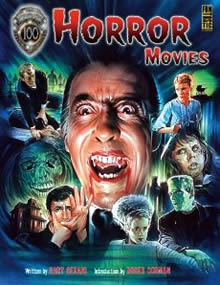 How did Top 100 Horror Movies come about? How did Top 100 Horror Movies come about?
I now have a relationship with the comic book company IDW. It seems Marvel’s #1 in the industry, DC’s #2, and IDW and Dark Horse generally fight it out for the #3 position. IDW is very enterprising, and I signed a five-year contract with them to do a series of books along the lines of Fantastic Television.
Reflecting this, my little publishing division is called Fantastic Press. That was the suggestion of my good friend Greg Goldstein, a key IDW executive, who grew up with Fantastic Television and just loved the idea of setting similar books in motion. So the goal is to create a series of books, covering all movie genres, that retain the visual excitement of Fantastic Television, but for more sophisticated 21st Century sensibilities. Basically, this is my personal choice for the Top 100; whether you agree with my rankings or not, no one disputes the fact that these are all great movies. And that’s part of the fun of it, debating about who's right and wrong. After all, I’ve had a loving relationship with most of these movies my entire life. Of course, both Pumpkinhead and IDW’s own 30 Days of Night were ineligible for the Top 100 contest, because of obvious conflict-of-interest reasons.
I also sold IDW on a graphic novel called Bram Stoker's Death Ship. This nightmarish tale expands the sequence from the original Dracula novel where he’s being transported from Transylvania to England on a Russian schooner and preys on the unsuspecting crew. Funny… This is something I’ve been wanting to write for nearly 25 years. Like I said earlier, non-fiction keeps you alive, but fiction is the dream, the ultimate prize. Sometimes it takes decades for a particular dream to happen, but we obsessed writers never seem to give up.
|
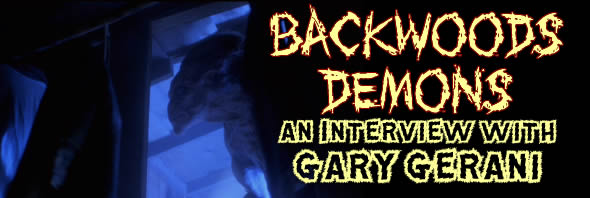

![]()